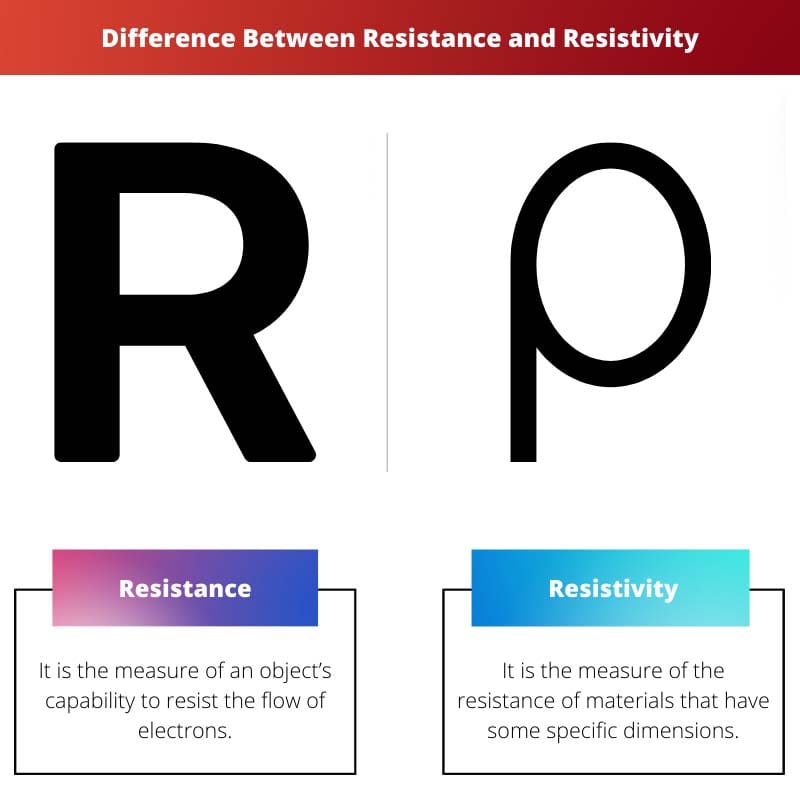It is a well-known fact that physics plays a crucial part in making us understand and analyze various concepts like heat, electricity, and so on.
It is the in-depth study of electricity in physics that enlightens us about complex topics of the flow of electric current in various materials.
Resistance and resistivity are two closely related yet different concepts that are related to the flow of electrons.
Key Takeaways
- Resistance mensuration how much a material opposes the flow of electricity.
- Resistivity is the intrinsic property of a material that describes how well it resists the flow of electricity.
- Resistance is directly proportional to resistivity.
Resistance vs Resistivity
The difference between Resistance and Resistivity is that the former is the conductor’s property to stop or resist the flow of electrons whereas the latter measures the resistance that a particular material offers per unit length for the unit cross-section. The two also differ in their formula, SI unit, application, etc.

Resistance is the measure of the amount of opposition that a conductor can provide to the free flow of its electrons. The length, area, and nature of the material, act as important factors in determining the resistance of the conductor.
Conductors have low resistance, while insulators have higher resistance. The SI unit of resistance is known as ohm(Ω).
Resistivity, on the other hand, is the measurement of resistance in a particular material under certain specific dimensions. When the temperature of the material rises, its resistivity also tends to increase.
Insulators have a higher resistivity when compared to conductors. Its SI unit is an ohms-meter.
Comparison Table
| Parameters of Comparison | Resistance | Resistivity |
|---|---|---|
| Definition | It is the measure of an object’s capability to resist the flow of electrons. | It is the measure of the resistance of materials that have some specific dimensions. |
| SI Unit | Ohm (Ω) is the SI unit of resistance. | Ohms-meter (Ω.m) is the SI unit of resistivity. |
| Symbol | Resistance is represented by the symbol R. | The symbol used to represent resistivity is ƿ |
| Application | Its application is useful in various devices. For instance, sensors, heaters, etc. | Its application is helpful in the quality control test. |
| Factors | The length, temperature, and cross-section area of the conductor, are some factors that determine Resistance. | Resistivity increases with an increase in temperature. |
What is Resistance?
Resistance can be termed as the property of a material whose work is to resist or stop the flow of electrons through its body. The resistance of a particular object primarily depends on a number of factors.
These include the length of the conductor, its area, temperature, and so on.
The more the length of the conductor, the more will be its resistance. Similarly, the resistance is also directly proportional to the temperature of its conductor.
Conversely, when the area of the conductor is less, its resistance will increase, and if the area is more, the resistance tends to drop.
For this reason, a wire that is thick and long will have more resistance when compared to a wire that is thin and short. Resistance is measured in the unit of ohm (Ω) which is a Greek letter called Omega.
Resistance is denoted by the symbol is R. Other than superconductors, all objects tend to resist the electric current.
To calculate the resistance of a particular object, one needs to use the formula R=V/I. Herein, R is resistance, V denotes voltage, and I stand for current. The primary use of resistance is in devices such as sensors, fuses, etc.
Resistance tends to be higher in insulators and lower in conductors.

What is Resistivity?
Resistivity is basically the physical property of a particular object or material that demonstrates its capacity to resist the flow of electric current but in certain specific dimensions.
Some other lesser-known terms for resistivity are volume resistivity and specific electrical resistance. Resistivity is affected by temperature.
When the temperature of a specific conductor or material is high, its resistivity tends to increase, and when it is low, the resistivity also dials down. Resistivity remains the same for similar materials.
For instance, all wires made up of copper will have the same resistivity irrespective of their length, size, area, etc.
It is for this reason that resistivity is an intrinsic property and is not governed by such factors. The symbol used to represent resistivity is known as rho (ƿ), which is a Greek letter. Just like resistance, resistivity has its SI unit too.
It is ohm-meter (Ω.m). Like resistance, resistivity too is higher in insulators and lower in conductors.
The application of resistivity comes into use while undergoing the quality control test. Resistivity is measured using a formula that is ƿ=(R*A)/L.
Here, ƿ means resistivity, R stands for resistance, A denotes the cross-sectional area of the conductor or the material, and L represents the length of the material.

Main Differences Between Resistance and Resistivity
- Resistance is the measure of a material’s capacity to resist the flow of electrons, while resistivity is the measure of a specific material’s resistance under certain dimensions.
- Resistance is denoted by the symbol R whereas resistivity is represented by the symbol ƿ (rho), a Greek letter.
- The SI units of the two also differ from each other. While ohm is the SI unit of resistance, the ohm-meter is for resistivity.
- Resistance is affected by factors such as the length, area, and temperature of the material, while resistivity is affected only due to a change in temperature.
- Both resistance and resistivity are higher in insulators and lower in conductors, but the two differ in their application. Resistance is used in devices such as heaters, and on the other hand, resistivity as a concept is used in quality control tests.



